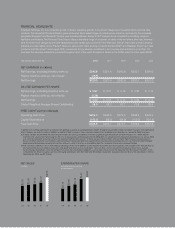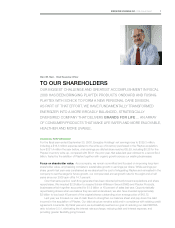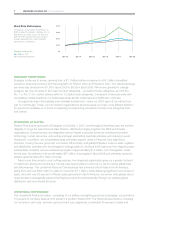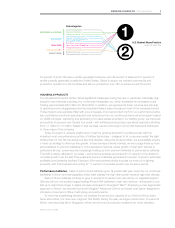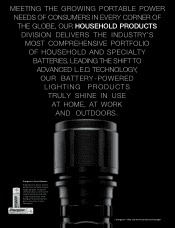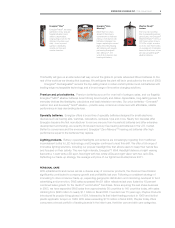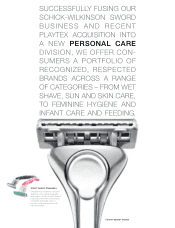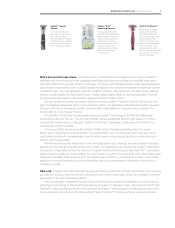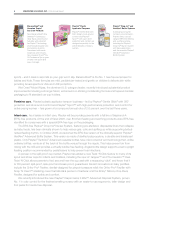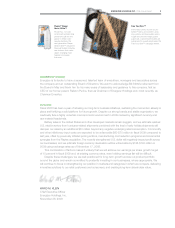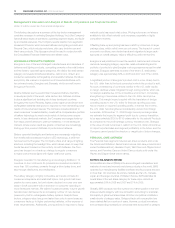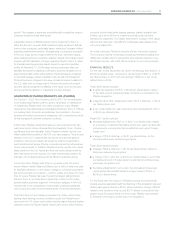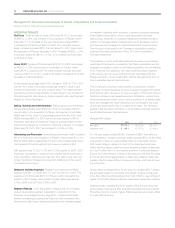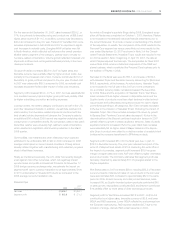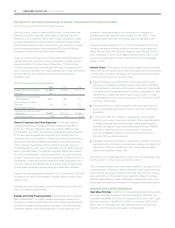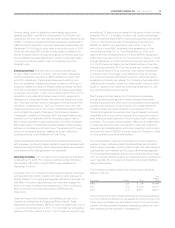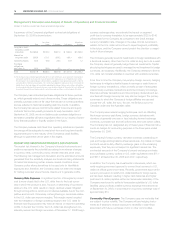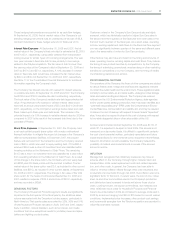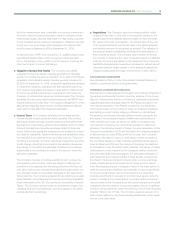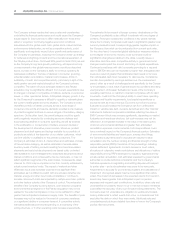Energizer 2008 Annual Report Download - page 12
Download and view the complete annual report
Please find page 12 of the 2008 Energizer annual report below. You can navigate through the pages in the report by either clicking on the pages listed below, or by using the keyword search tool below to find specific information within the annual report.
10 ENERGIZER HOLDINGS, INC. 2008 Annual Report
Management’s Discussion and Analysis of Results of Operations and Financial Condition
(Dollars in millions, except per share and percentage data)
The following discussion is a summary of the key factors management
considers necessary in reviewing Energizer Holdings, Inc.’s (the Company)
historical basis results of operations, operating segment results, and liquid-
ity and capital resources. The Company reports results in two segments:
Household Products, which includes batteries and lighting products and
Personal Care, which includes wet shave, skin care, feminine care and
infant care products. This discussion should be read in conjunction with
the Consolidated Financial Statements and related notes.
HOUSEHOLD PRODUCTS OVERVIEW
Energizer is one of the world’s largest manufacturers and marketers of
batteries and lighting products, competing primarily in the retail battery
and the battery-operated lights categories. We define the retail battery
category as household batteries (alkaline, carbon zinc, lithium and
consumer replaceable rechargeable) and specialty batteries (miniature
and photo). We market a complete line of household batteries with
two primary brands, Energizer and Eveready, which are well known
throughout the world.
Alkaline batteries are the predominant household battery chemistry
in developed parts of the world, while carbon zinc batteries continue
to play a significant yet declining role in less developed countries
throughout the world. Recently, higher power, higher priced lithium and
rechargeable batteries have grown in response to more demanding power
needs of more advanced devices. The Company is well positioned to
meet consumers’ household battery needs with a comprehensive portfolio
of battery technology to meet a wide variety of device power require-
ments. In less developed markets, the Company encourages trade-up
from value priced batteries to premium batteries; in more developed
markets, where power needs are greater, consumers are increasingly
trading-up from premium batteries to performance batteries.
Battery-operated flashlights and lanterns are increasingly migrating
from traditional incandescent bulbs to LED technology, a shift that
has been led by Energizer. The Company offers a full range of lighting
solutions, including the headlight line, which allows users to keep their
hands free and focused on their activity. As with batteries, the Com-
pany has focused on a trade-up strategy to migrate consumers
to higher performance lights with higher retail price points.
Energizer operates 19 manufacturing and packaging facilities in 12
countries on four continents. Its products are marketed and sold in
more than 165 countries, primarily through a direct sales force, and
also through distributors and wholesalers.
The battery category is highly competitive as brands compete for
consumer acceptance and retail shelf space. Unit growth had been
positive for many years, but unit volume declined on a year over year
basis in 2008 coincident with a slowdown in consumer spending in
most developed markets. We believe household battery volume growth
has also been dampened by an increasing number of new devices
powered by built in rechargeable battery systems. Despite these
factors, category value has grown faster than units in recent years as
consumers trade up to higher performing batteries, at the expense of
lower value batteries. Additionally, pricing actions in response to rising
material costs has raised retail prices. Pricing actions are not always
available to fully offset material cost increases, especially in highly
competitive markets.
Offsetting trade-up and pricing has been a shift by consumers to larger
package sizes, which sell at lower per unit prices. The impact of current
economic conditions, new device trends and migration to larger pack-
age sizes on overall category value is difficult to predict at this time.
Energizer is well positioned to meet the needs of customer and consumer
demands, leveraging category expertise, retail understanding and its
portfolio of products to give Energizer a strong presence across the retail
channels. Energizer estimates its share of the total U.S. retail battery
category was approximately 39% in 2008 and 2007 and 37% in 2006.
A significant portion of Energizer’s product cost is more closely tied to
the U.S. dollar than to the local currencies in which the product is sold.
As such, a weakening of currencies relative to the U.S. dollar results
in margin declines unless mitigated through pricing actions, which are
not always available due to the competitive environment. Conversely,
strengthening of currencies relative to the U.S. dollar can improve
margins. This margin impact coupled with the translation of foreign
operating results to the U.S. dollar for financial reporting purposes
has an impact on reported operating profits. In the last few months,
the U.S. dollar has strengthened considerably versus most foreign
currencies. At November 17, 2008 foreign currency exchange rates,
we estimate the impact to segment profit due to currency translation
to be approximately $100 to $110 unfavorable for Household Products
as compared to the 2008 average currency translation rate. Changes
in the value of local currencies in relation to the U.S. dollar will continue
to impact reported sales and segment profitability in the future, and the
Company cannot predict the direction or magnitude of future changes.
PERSONAL CARE OVERVIEW
The Personal Care segment includes wet shave products sold under
the Schick and Wilkinson Sword brand names, skin care products sold
under the Banana Boat, Hawaiian Tropic, Wet Ones and Playtex brand
names, and Feminine Care and Infant Care products sold under the
Playtex and Diaper Genie brand names.
SCHICK-WILKINSON SWORD
Schick-Wilkinson Sword (SWS) is the second largest manufacturer and
marketer of men’s and women’s wet shave products in the world. SWS
operates four manufacturing facilities worldwide and its products are sold
in more than 140 countries. Its primary markets are the U.S., Canada,
Japan and the larger countries of Western Europe. SWS estimates its
overall share of the wet shave category for these major markets at
approximately 20% in 2008 and 2007 and 21% in 2006.
Globally, SWS products hold the number two market position in the wet
shave products category, with one competitor accounting for a substan-
tial majority of global wet shave sales. All other competitors constitute a
small minority of category sales. Category blade unit consumption has
been relatively flat for a number of years. However, product innovations
and corresponding increased per unit prices have accounted for category


